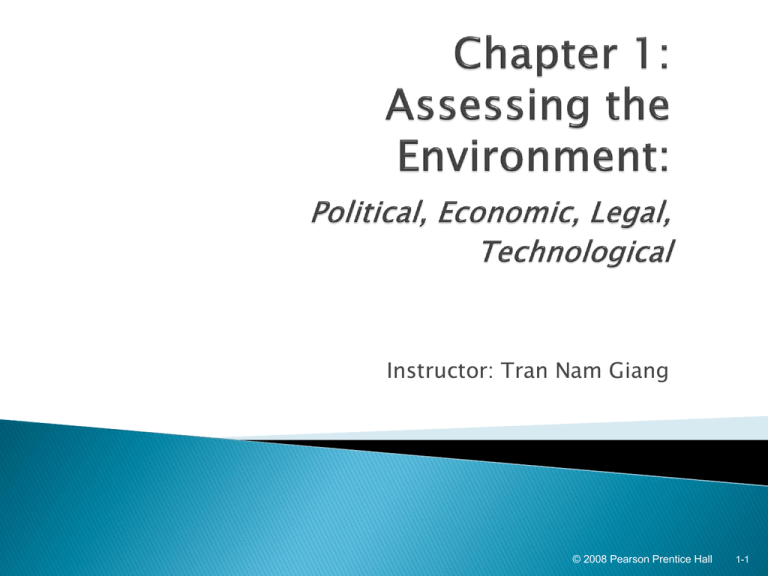
Instructor: Tran Nam Giang
© 2008 Pearson Prentice Hall
1-1
Research
the environment in
which a company operates or will
operate in order to assess:
1. the political risks
2. the economic risks
3. the regulatory risks
4. technological risks
© 2008 Pearson Prentice Hall
1-2
Any governmental action or politically
motivated event that could adversely affect
the long-run profitability or value of a firm
Example:
Why do governments do that?
“… Bolivia nationalized its natural-gas
industry, ordering foreign companies to give
up control of fields and accept much tougher
operating terms within six months or leave
the country”
Wall Street Journal 2006
© 2008 Pearson Prentice Hall
1-3
Expropriation of corporate assets
Forced sale of equity to host-country
nationals
Legal discrimination
Barriers to repatriation of funds
Loss of technology or other IP
Interference in managerial decision
making
Dishonesty by government officials
regarding contracts
© 2008 Pearson Prentice Hall
1-4
© 2008 Pearson Prentice Hall
1-5
© 2008 Pearson Prentice Hall
1-6
© 2008 Pearson Prentice Hall
1-7
© 2008 Pearson Prentice Hall
1-8
© 2008 Pearson Prentice Hall
1-9
© 2008 Pearson Prentice Hall
1-10
© 2008 Pearson Prentice Hall
1-11
Helps companies manage exposure to
risk and minimize financial loss
Two forms:
◦ Consultation with experts
◦ Development of internal staff capabilities
© 2008 Pearson Prentice Hall
1-12
Avoidance
Adaptation: equity sharing,
localization, development assistance
Dependency: keep subsidiary & host
nation dependent on parent firm
Hedging: insurance, local debt
financing
© 2008 Pearson Prentice Hall
1-13
Is closely related to political risk
Types of economic risks
◦ Loss of profitability due to abrupt
changes in monetary and fiscal policies
◦ Loss of profitability due to changes in
foreign investment policies.
E.g. barriers in profit repatriation,
changes in interest rate, exchange
rate
© 2008 Pearson Prentice Hall
1-14
Quantitative: assess economic variables
(GDP, income, unemployment rate,
inflation, budget, imports, exports,
debts)
Qualitative: assess the competence of
leaders
Checklist: easily measurable and timely
criteria
A combination of these methods
© 2008 Pearson Prentice Hall
1-15
Protectionist policies, such as tariffs
or quotas
The attractiveness of the tax system
The level of government involvement
in the economic and regulatory
environment
© 2008 Pearson Prentice Hall
1-16
The appropriability of technology:
ability to profit from innovating
technology maybe restricted
Inappropriate use of technology by
others
Appropriateness of technology for the
local environment
© 2008 Pearson Prentice Hall
1-17







